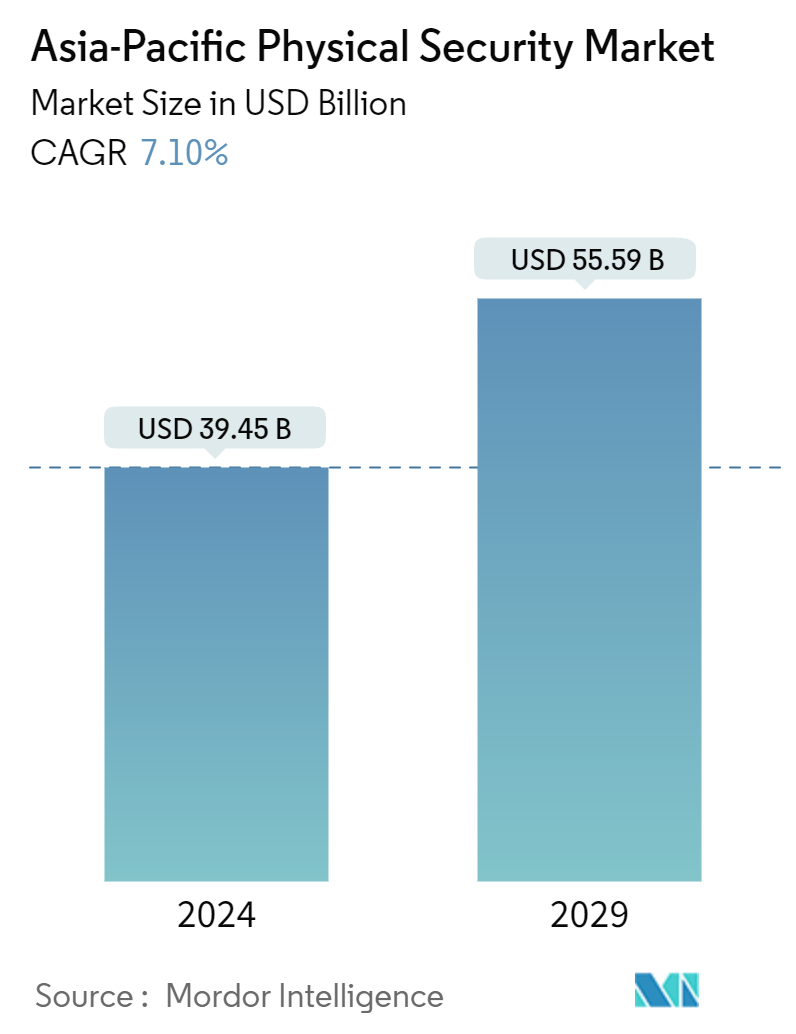Market Size of Asia-Pacific Physical Security Industry

| Study Period | 2019 - 2029 |
| Base Year For Estimation | 2023 |
| Market Size (2024) | USD 39.45 Billion |
| Market Size (2029) | USD 55.59 Billion |
| CAGR (2024 - 2029) | 7.10 % |
| Market Concentration | Low |
Major Players
*Disclaimer: Major Players sorted in no particular order |
Asia-Pacific Physical Security Market Analysis
The Asia-Pacific Physical Security Market size is estimated at USD 39.45 billion in 2024, and is expected to reach USD 55.59 billion by 2029, growing at a CAGR of 7.10% during the forecast period (2024-2029).
- Physical security refers to protecting assets, such as data, software, hardware, and individuals, from unanticipated events that could result in loss or damage to these assets. Across the Asia-Pacific, physical security has become just as crucial for modern businesses as cybersecurity, protecting them from various risks, such as vandalism, theft, burglary, and natural disasters, such as fires or floods. The growing demand for high-safety protocols drives the adoption of physical security systems.
- The physical security market has undergone a significant transformation in the past decade due to the rapid advancements of cloud computing and the availability of video surveillance software. Additionally, the increasing awareness of public safety and security issues has led to expanding IP-based camera and video management systems.
- Also, the increased investment in smart city initiatives and decreased IP camera prices have increased the demand for physical security systems to protect citizens. These factors are the primary drivers of growth in the region's physical security market.
- The widespread utilization of AI-based technologies in the defense sector encompasses a wide range of roles and applications, including monitoring, logistics, cyber security, unmanned aerial vehicles (UAVs), sophisticated military equipment such as Lethal Autonomous Weapon Systems (LAWS), and autonomous combat vehicles (ACVs) and robots. These applications provide a strong foundation for modern warfare strategies.
- For instance, in August 2023, India implemented AI-based border surveillance solutions to strengthen border security by incorporating camera, radar, and sensor technology. The Indian Army installed approximately 140 AI-based border surveillance systems to acquire live feed from the Pakistani and Chinese borders. Utilizing these advanced technologies facilitates the detection of border intrusions, the identification of target classification, and the optimization of defense operations. The implementation of high-tech solutions reduces human involvement in monitoring and facilitates the detection of intrusions in more remote areas, such as the Line of Actual Control (LAC).
- Physical security systems, such as biometric authentication and real-time monitoring, are designed to prevent fraudulent activity and theft attempts against financial targets, thus providing a secure environment for clients and their assets. The proliferation of sophisticated cyberattacks and financial crimes has necessitated a heightened demand for physical security systems to safeguard banking operations' safety.
- In January 2023, the Indian government allowed banks to use facial recognition and, in a few cases, Iris scan to authenticate individual transactions that exceeded the annual limit of INR 2.0 million (USD 0.024 million). The new rules can be used to verify the identity of individuals who make deposits and withdrawals of more than INR 2.0 million (USD 0.024 million) in any financial year, provided they share their Aadhaar identity card as proof of identification.
- Despite technological advancements, physical security systems remain susceptible to physical data breaches and manipulation. The increasing data privacy concerns of consumers are restraining the growth of the physical security systems market. Not only are customers hesitant to adopt such solutions, but governments are also regulating the use and storage of data. As a result, enterprises need help creating datasets and expanding their offerings. For instance, according to AAG, between the Q2 and Q3 quarters of 2022, China experienced the highest number of data breaches, with 14,157,775 accounts breached.
- The physical security market is growing steadily. It was slightly affected by the COVID-19 pandemic. However, post-COVID-19, the customers moved away from traditional video cameras and toward IP-based cameras. The countries in Asia-Pacific have started investing heavily in smart city initiatives, helping grow the physical security market. Also, after the pandemic ended, the situation caused an increase in the digitization of overall commercial operations in the region. This led to a rise in the need for physical security systems in the Asia-Pacific region.
Asia-Pacific Physical Security Industry Segmentation
Physical security refers to preventing unauthorized intruders from accessing controlled facilities. Physical security technologies have developed significantly recently, offering advanced protection at competitive prices. Physical security devices utilize cloud technology and AI for even more sophisticated real-time data processing. Various automated physical security components can perform multiple functions in a physical security system.
The Asia-Pacific physical security market is segmented by system type (video surveillance system [IP surveillance, analog surveillance, and hybrid surveillance], physical access control system (PACS), biometric system, perimeter security, and intrusion detection), service type (Access Control-as-a-Service (ACaaS) and Video Surveillance-as-a-Service (VSaaS)), type of deployment (on-premises and cloud), organization size (SMEs and large enterprises), end-user industry (government services, banking and financial services, IT and telecommunications, transportation and logistics, retail, healthcare, residential, and other end-user industries), and country (China, Japan, India, and the Rest of Asia-Pacific). The report offers the market sizes and forecasts for all the above segments in terms of value (USD).
| By System Type | |||||
| |||||
| Physical Access Control System (PACS) | |||||
| Biometric System | |||||
| Perimeter Security | |||||
| Intrusion Detection |
| By Service Type | |
| Access Control-as-a-Service (ACaaS) | |
| Video Surveillance-as-a-Service (VSaaS) |
| By Type of Deployment | |
| On-premises | |
| Cloud |
| By Organization Size | |
| SMEs | |
| Large Enterprises |
| By End-user Industry | |
| Government Services | |
| Banking and Financial Services | |
| IT and Telecommunications | |
| Transportation and Logistics | |
| Retail | |
| Healthcare | |
| Residential | |
| Other End-user Industries |
| By Country*** | |
| China | |
| Japan | |
| India | |
| South Korea | |
| Australia and New Zealand |
Asia-Pacific Physical Security Market Size Summary
The Asia-Pacific physical security market is experiencing significant growth, driven by the increasing need to protect assets and individuals from various threats such as theft, vandalism, and natural disasters. This market is becoming as essential as cybersecurity for modern businesses, with the adoption of advanced physical security systems being propelled by the demand for high-safety protocols. The market has transformed over the past decade due to advancements in cloud computing and video surveillance software, alongside a heightened awareness of public safety issues. The proliferation of smart city initiatives and the decreasing costs of IP cameras have further fueled the demand for physical security solutions in the region. These systems are crucial for safeguarding citizens and are increasingly integrated with AI and machine learning technologies to enhance their effectiveness.
The market is characterized by a competitive landscape with numerous players engaging in strategies such as product innovation, partnerships, and mergers to strengthen their market position. Companies like Honeywell, Bosch Security Systems, and Dahua Technology are prominent in this space, offering a range of solutions from video surveillance to access control systems. The demand for advanced video surveillance systems, particularly in airports and urban areas, is on the rise, driven by the need for enhanced security measures. Additionally, the integration of biometric authentication and real-time monitoring systems is becoming more prevalent, especially in sectors like banking, to combat financial crimes. Despite the growth, concerns over data privacy and regulatory challenges pose potential restraints on market expansion, necessitating a careful balance between security and privacy.
Asia-Pacific Physical Security Market Size - Table of Contents
-
1. MARKET INSIGHTS
-
1.1 Market Overview
-
1.2 Industry Attractiveness - Porter's Five Forces Analysis
-
1.2.1 Bargaining Power of Suppliers
-
1.2.2 Bargaining Power of Consumers
-
1.2.3 Threat of New Entrants
-
1.2.4 Threat of Substitutes
-
1.2.5 Intensity of Competitive Rivalry
-
-
1.3 Impact of COVID-19 Aftereffects and Other Macroeconomic Factors on the Market
-
-
2. MARKET SEGMENTATION
-
2.1 By System Type
-
2.1.1 Video Surveillance System
-
2.1.1.1 IP Surveillance
-
2.1.1.2 Analog Surveillance
-
2.1.1.3 Hybrid Surveillance
-
-
2.1.2 Physical Access Control System (PACS)
-
2.1.3 Biometric System
-
2.1.4 Perimeter Security
-
2.1.5 Intrusion Detection
-
-
2.2 By Service Type
-
2.2.1 Access Control-as-a-Service (ACaaS)
-
2.2.2 Video Surveillance-as-a-Service (VSaaS)
-
-
2.3 By Type of Deployment
-
2.3.1 On-premises
-
2.3.2 Cloud
-
-
2.4 By Organization Size
-
2.4.1 SMEs
-
2.4.2 Large Enterprises
-
-
2.5 By End-user Industry
-
2.5.1 Government Services
-
2.5.2 Banking and Financial Services
-
2.5.3 IT and Telecommunications
-
2.5.4 Transportation and Logistics
-
2.5.5 Retail
-
2.5.6 Healthcare
-
2.5.7 Residential
-
2.5.8 Other End-user Industries
-
-
2.6 By Country***
-
2.6.1 China
-
2.6.2 Japan
-
2.6.3 India
-
2.6.4 South Korea
-
2.6.5 Australia and New Zealand
-
-
Asia-Pacific Physical Security Market Size FAQs
How big is the Asia-Pacific Physical Security Market?
The Asia-Pacific Physical Security Market size is expected to reach USD 39.45 billion in 2024 and grow at a CAGR of 7.10% to reach USD 55.59 billion by 2029.
What is the current Asia-Pacific Physical Security Market size?
In 2024, the Asia-Pacific Physical Security Market size is expected to reach USD 39.45 billion.

